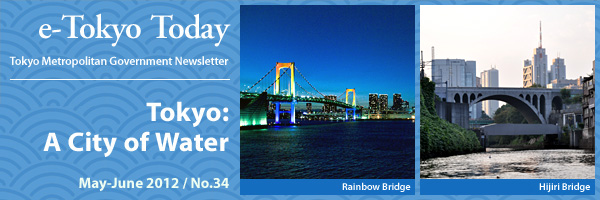
 |
|
News & Announcements |
|
|
"Like" Us if You Are a Fan of Tokyo: TCVB Now Has its Own Facebook Page!
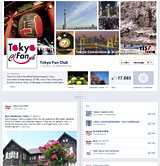 The Tokyo Convention & Visitors Bureau (TCVB) launched its official "Tokyo Fan Club" Facebook page on March 19, 2012, where Tokyo fans and soon-to-be fans can find all the latest information on one of the most exciting cities in the world. The Tokyo Convention & Visitors Bureau (TCVB) launched its official "Tokyo Fan Club" Facebook page on March 19, 2012, where Tokyo fans and soon-to-be fans can find all the latest information on one of the most exciting cities in the world.It already received more than 17,000 "likes" in the first month. Tokyo Fan Club (English) Tokyo Fan Club (Japanese) |
|
|
Go Tokyo!: Websites of TMG and TCVB Have Merged
Two websites focusing on Tokyo tourism, one of the Tokyo Metropolitan Government and one of TCVB, have merged as of May 21, 2012. The URL has changed, so please visit and re-bookmark: http://www.gotokyo.org "GO TOKYO," our re-launched website, currently features "TOKYO SKYTREE®," the newest Tokyo landmark as a bimonthly special topic. In addition, the new website will later include a good list of way to experience traditional culture, more detailed information on school trips and exchange programs. |
|
|
KIDDY LAND Harajuku to Reopen on July 1
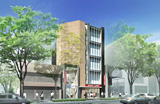 Harajuku KIDDY LAND, under renovation since August 2010, will reopen on July 1, 2012. The renewal will feature specialty shops such as "SNOOPY Town Shop Harajuku," "PrismStone," "Rilakkuma Store Harajuku," and a "Hello Kitty Shop Harajuku" offering the latest in popular character goods including the "Disney Corner" (tentative name). Harajuku KIDDY LAND, under renovation since August 2010, will reopen on July 1, 2012. The renewal will feature specialty shops such as "SNOOPY Town Shop Harajuku," "PrismStone," "Rilakkuma Store Harajuku," and a "Hello Kitty Shop Harajuku" offering the latest in popular character goods including the "Disney Corner" (tentative name).This Harajuku flagship store is 150 meters away from the temporary Cat Street Store (to be closed in June) and on Omotesando Street. KIDDY LAND |
|
|
Tokyo: A City of Water |
|||||||||
|
Tokyo may not be the first city that springs to mind when imagining "a city of water" but for the 13 million people living there it actually is. For hundreds of years, the waterways in Tokyo were the arteries for commerce and transportation and covered 20% of the center of Edo (the old name for Tokyo). The downtown areas, including Asakusa and Ryogoku along the Sumida River, prospered and so a number of historic sites are within these areas. Following the Sumida River Renaissance, new landmarks and tourist facilities such as TOKYO SKYTREE® and Tokyo Gate Bridge are opening along the waterside and the water city of Tokyo is more enjoyable than ever. Let's look at both the "Old" and "New" aspects.
Urban Cruise in Various Styles
The 360 panoramic view of Tokyo Bay from the boat slowly cruising the bay is surprisingly different than when seen from land, and, especially in the evening, the dramatic night view of the Rainbow Bridge and the high-rises in Odaiba are unforgettable.Water Bus 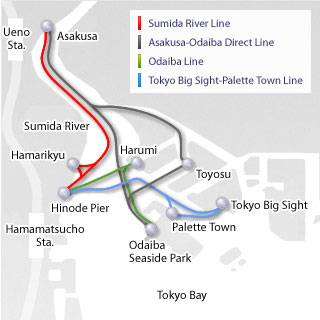 As trucks have replaced barges in modern times, the industrial water traffic of the old days has basically disappeared, but one type of boat is doing a thriving trade - water buses. There are four lines - Sumida River, Asakusa-Odaiba, Odaiba and Tokyo Big Sight-Palette Town. As trucks have replaced barges in modern times, the industrial water traffic of the old days has basically disappeared, but one type of boat is doing a thriving trade - water buses. There are four lines - Sumida River, Asakusa-Odaiba, Odaiba and Tokyo Big Sight-Palette Town.Especially Sumida River Line, ferrying passengers between Asakusa and Hamarikyu Gardens taking about 35 minutes, is one business that seems timeless. The bridges passed under are all different in design and the landscape is constantly changing with houses that look like they belong in a period drama nestled between the modern high-rises. Passengers will see the Tsukiji fish market on the right-hand side 30 minutes after the start. Passengers get off at Hamarikyu Gardens, originally the Shogunal hawking grounds. Tokyo Cruise Futuristic Himiko 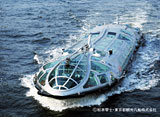 Although boats of a number of designs ply these waterways, "Himiko," a boat based in Odaiba, is particularly eye-catching. It is named after the queen of a legendary country in ancient Japan and its sleek futuristic design by the famous cartoonist Leiji Matsumoto makes it appear to be something destined for orbit rather than a river cruise. Although boats of a number of designs ply these waterways, "Himiko," a boat based in Odaiba, is particularly eye-catching. It is named after the queen of a legendary country in ancient Japan and its sleek futuristic design by the famous cartoonist Leiji Matsumoto makes it appear to be something destined for orbit rather than a river cruise.Himiko Old-fashioned Houseboat (Yakatabune) 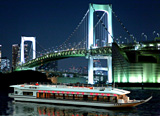 Houseboats with low roofs and tatami-mat flooring were popular in the Edo period as water transport and for recreation as well for people in Edo. The boats still offer great night views of modern Tokyo and the opportunity to try traditional Japanese foods like tempura, sashimi and sushi. A yakatabune experience is especially good for events such as viewing cherry blossoms in spring and fireworks in summer. Moon viewing in autumn, when the moon is said to be most beautiful, is a Japanese custom, and viewing from yakatabune has become popular recently. Houseboats with low roofs and tatami-mat flooring were popular in the Edo period as water transport and for recreation as well for people in Edo. The boats still offer great night views of modern Tokyo and the opportunity to try traditional Japanese foods like tempura, sashimi and sushi. A yakatabune experience is especially good for events such as viewing cherry blossoms in spring and fireworks in summer. Moon viewing in autumn, when the moon is said to be most beautiful, is a Japanese custom, and viewing from yakatabune has become popular recently.Many companies operate yakatabune, mostly departing from around Asakusa and Shinagawa, and cruising the Sumida River and Tokyo Bay. If you want to experience an old-time Japanese atmosphere, yakatabune is a good choice. Most boats operate for private, chartered use but some companies operate share-ride boats. The cost is about 10,500 JPY (100 JPY = 1.25 USD) per person. Amisei Funasei Harumiya Nakakin Nawayasu Cruise with Cuisine in Tokyo Bay Gourmet lovers can partake of delicious cuisine while enjoying a cruise. A variety of cruise tours offer French, Italian, and other dining while cruising Tokyo Bay. Dine or have a cup of tea in the soft sea breeze as you float past the twinkling skyscrapers in the panoramic view. Enjoy the romance. Vingt et un Symphony Crystal Yacht Club Must-see Bridges
Where there are rivers, there are bridges. As a charming city of water, Tokyo has a lot of them, both futuristic and historical ones, that harmonize well with the landscape.Tokyo Gate Bridge: Brand new "dinosaur" bridge
From the center of the bridge, 61 meters above sea level, the panorama of Tokyo Bay is splendid. In particular, it offers a great view of the skyscrapers in the new Tokyo waterfront area, Haneda Airport, Tokyo Tower and TOKYO SKYTREE® in the distance. Even Mt. Fuji can be seen on clear days. It is illuminated with 886 LED lights that are changed every month and create a fantastic view. Illuminations are on from sunset to midnight. About 40% of the power is provided by solar power, so the pair of dinosaurs is eco-conscious. Access: PDF (Japanese Only) [By bus] Shin-kiba Station on the JR Keiyo Line -> Wakasu Kyampujo-mae Bus Stop 15 min by bus bound for " Time table of bus from Shin-kiba Station to the bridge (Japanese Only) [On foot] (4.4 km) Shin-kiba Station -> Turn left at Shin-kiba-eki Intersection -> (1 km) Turn right at the second traffic light -> (3.4 km) Go straight to Wakasu Park Map Tokyo Gate Bridge (Japanese only) Rainbow Bridge: Odaiba Landmark
Access: [Shibaura side] 5 min from Shibaura-futo Station on the Yurikamome Line on foot [Odaiba side] 10 min from Odaiba Kaihin-koen Station on the Yurikamome Line on foot Map Metropolitan Expressway company ltd Hijiri Bridge: Historic bridge between two "sacred" places
"Hijiri" means "sacred," named after the two sacred buildings on either side of the river. On one side is the Yushima Seido Temple, north of the bridge with its origin in the Confucian temple in Ueno. It was moved to Yushima Temple in 1690 by Tsunayoshi, the fifth shogun of the Tokugawa Shogunate. This is known as the birthplace of school education in Japan. On the opposite side is the Holy Resurrection Cathedral known as Nikorai-do (Japanese only), the main cathedral of the Orthodox Church in Japan, a magnificent cathedral with a big dome. The building, first built in 1891, was damaged by the Great Kanto Earthquake and the present, renovated building was designated a national important cultural property in 1962. The first and one of the biggest authentic Byzantine churches in Japan is worthwhile to see. The bridge is designed to be most picturesque when seen from a boat on the river but a similar perspective can be seen from platforms of JR Ochanomizu Station. The scenery from the bridge is also nice. Access: 2 min from JR Ochanomizu Station on the JR Chuo/Sobu Line or Tokyo Metro Marunouchi line on foot Map Kachidoki Bridge: An important national cultural property 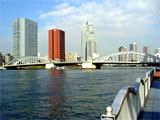 The Kachidoki Bridge spans the Sumida River near the Tsukiji fish market. It was built in 1940 and is one of the rare bascule bridges in Japan. In the past, it attracted many people who just wanted to watch the two sides separate (or draw) and rise 70 degrees for vessels to pass under the river. It used to draw five times a day for about 20 minutes, but, unfortunately, the operation stopped in 1970 due to the decrease in vessels and increase in car traffic. The Kachidoki Bridge spans the Sumida River near the Tsukiji fish market. It was built in 1940 and is one of the rare bascule bridges in Japan. In the past, it attracted many people who just wanted to watch the two sides separate (or draw) and rise 70 degrees for vessels to pass under the river. It used to draw five times a day for about 20 minutes, but, unfortunately, the operation stopped in 1970 due to the decrease in vessels and increase in car traffic.It was designated as a national important cultural property along with the Kiyosu Bridge and Eitai Bridge, both of which are bridges over the Sumida River in Tokyo. Access: 10 min from Kachidoki Station on the Toei Oedo Line on foot, or 15 min from Tsukiji Station on the Tokyo Metro Hibiya Line on foot Map Intriguing Water Spots in the Heart of Tokyo
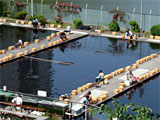 Ichigaya Fish Center Ichigaya Fish CenterYou need not go far from the center of Tokyo to find a unique water spot. From the train on the JR Chuo Line or the Sobu Line near Ichigaya Station, you can see a pond with people sitting around it here and there. It is a fishing pond, from the moat of the then Edo Castle. Commuter trains busily run past the pond while fishermen peacefully fish looking relaxed. The cost is 690 JPY (100 JPY = 1.25 USD) per hour per person (adult) plus 80 JPY (bait), 100 JPY (rod). Access: 1 min from Ichigaya Station on the JR Sobu Line or Tokyo Metro Yurakucho/Namboku lines on foot Map Ichigaya Fish Center (Japanese Only) Canal Café Iidabashi, next station to Ichigaya, has another cool water spot. Canal Café, a one-minute walk from Iidabashi Station, appears to float on the water in a resort-like setting. You can see canal wildlife such as fireflies, wild birds, turtles, and carp, from wonderful waterfront. It is popular for Tokyoites as well as tourists in every season but particularly attracts scores of people in spring because of the gorgeous cherry blossom trees along the canal. The lit-up blossoms are especially beautiful in the evening. Access: 2 min from Iidabashi Station on the JR Sobu Line, Tokyo Metro Tozai Line, or Toei Oedo Line on foot Map Canal Café (Japanese Only) Meiji Jingu Meiji Jingu, near to Harajuku Station, stands in a lush forest. In the Imperial Garden, there is the "Well of Kiyomasa," said to be built by Lord Kato Kiyomasa (1562-1611). Many people feel something sacred or spiritual at this well and so it has become a popular "spiritual spot" in recent days. A perennial well of clear water that naturally springs from the underground is literally an oasis in the big city. Map Meiji Jingu Tokyo, though it is a metropolis, is blessed with the ocean, rivers, canals, and many places where you can enjoy the waterfront. Come and enjoy the many scenic waters of Tokyo and feel cool in the city! |
|||||||||
Event Information |
|
Tori no Ichi (Bamboo Rake Fair)
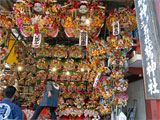 Ichi no Tori: November 8, 2012 Ichi no Tori: November 8, 2012Ni no Tori: November 20, 2012 Juzaisan Chokoku-ji, Asakusa, and other shrines Tori no Ichi or Otori Sai are fairs that take place on Tori no Hi in November. Tori no Hi is the day of the rooster, one of the 12 animals of the traditional Chinese zodiac calendar. The origin of Tori no Ichi dates back to the early 15th century. The local people of Hanamata-mura (Hanamata Village) in northern Tokyo held a harvest festival to give thanks to Hanamata Washidaimyojin, the god of Otori Shrine in Hanamata. They dedicated a live rooster to the god on the day of the festival to pray for good fortune and successful business. The specialty "good luck" item sold at the Tori no Ichi is kumade, a bamboo rake. Why a bamboo rake? It is said to rake in good fortune. There are many stalls at the fair selling bamboo rakes with traditional decorations such as the mask of okame (a woman who brings good luck) and koban (Edo-era oval gold coins). The designs are different depending on the stall, so searching for your favorite designs is sure to be fun. Map Tori no Ichi |
|
Hagoita Ichi (Battledore Fair)
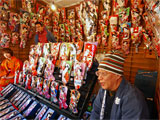 December 17-19, 2012 December 17-19, 2012Senso-ji Temple, Asakusa The annual Hagoita-ichi (Hagoita Market), held from December 17 to 19 at Senso-ji Temple, is one of the famous seasonal events in Asakusa. The Hagoita Ichi was originally a place to wish for the healthy development of female children because the hagoita (wooden paddle) is supposedly capable of knocking away evil spirits. The current style of the market dates back to the late 1800s when hagoita were a major product sold at the year-end bargain sales held at Senso-ji Temple. Hagoita were originally used in a game called hanetsuki, usually played by girls at the beginning of the year. Thought to be capable of driving away evil, they were given to women on New Year's Day. Over the years, the hagoita became more elegantly decorated. Oshie-hagoita with motifs of popular kabuki-stars and beautiful women from famous stories became very popular during the Edo period. Map Senso-ji Temple |
|
Daruma Fair at Haijima Daishi
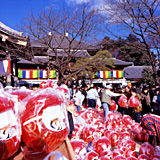 January 2 & 3, 2013 January 2 & 3, 2013Haijima-daishi, Haijima-cho, Akishima City The Daruma Fair takes place annually in the beginning of January, at Haijima Daishi, a temple located in western Tokyo famous for protection from evil. At the fair, about 600 stalls sell Tama daruma dolls, a specialty of this area. Daruma is a roly-poly papier-mâché doll shaped like Dharma (the founder of the Zen Buddism) in a kneeling position. It is weighted at the bottom so that even when pushed over, it springs back to an upright position. It is believed to invite good fortune. The silk reeling industry prospered in this area from the latter half of the 18th century trading silk and other fabrics. The farmers near Haijima Daishi as side business started making daruma dolls for their mascot to wish for a rich harvest and good health. The daruma market eventually became more popular than the textile market. A daruma is typically painted red except for the face. The eyes are blank so people paint in one pupil, make a wish, and paint in the other when the wish comes true. The designs and the faces of the dolls are different depending on the stall. Recently more and more variations from the traditional red can be found. Visit the temple for a New Year's visit and buy a doll to make sure your wish comes true. Access: 20 min from Akishima Station on the JR Ome Line on foot, or 25 min from JR Tachikawa Station by Tachikawa Bus -> 1 min from Haijima-daishimae Stop on foot Map |
|
Did you Know? Fun Facts About Tokyo: Inverted Image of TOKYO SKYTREE® from Jukken Bridge |
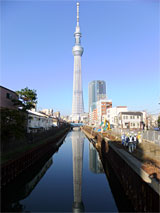 Japanese people have long loved seeing mirror images of Mt. Fuji reflected on the water called "Sakasa Fuji," and now the mirror image of TOKYO SKYTREE®, the highest freestanding tower in the world, can be seen from Jukken Bridge over the Kita-jukken River. The river flows east to west past the south side of the tower and Jukken, a small bridge 19 meters long and 15 meters wide, offers a splendid view of a shimmering "Sakasa (inverted) SKYTREE®." The contrast of the two "towers" makes an amazing scene, and more and more people are coming to get their best shot! Japanese people have long loved seeing mirror images of Mt. Fuji reflected on the water called "Sakasa Fuji," and now the mirror image of TOKYO SKYTREE®, the highest freestanding tower in the world, can be seen from Jukken Bridge over the Kita-jukken River. The river flows east to west past the south side of the tower and Jukken, a small bridge 19 meters long and 15 meters wide, offers a splendid view of a shimmering "Sakasa (inverted) SKYTREE®." The contrast of the two "towers" makes an amazing scene, and more and more people are coming to get their best shot!The bridge is about five minutes on foot from Oshiage Station. Map |
|
No Negative Impact on Our Health: Updated Radiation-related Information in Tokyo
|
|
Radiation Level in the Air (Tokyo Metropolitan Institute of Public Health)
Environmental radiation levels in Tokyo Radiation Level in Tap Water (Bureau of Waterworks Tokyo Metropolitan Government) No radioactive substances have been detected either from raw water or at the water purification plants of Tokyo since April 2011. Latest information related to the effect on purified water by radioactivity List of banned foods and shipping restrictions Food products are monitored every day for radioactive materials. The Japanese government restricts distribution and consumption of food products containing any level of radiation that exceeds the regulatory standards. Ministry of Health, Labour and Welfare: Information on the Great East Japan Earthquake Q&A on Foods and Fishery products Ministry of Agriculture, Forestry and Fisheries: Revised FAQ on vegetables, shiitake mushroom, rice, milk, dairy products, meat and eggs (as of February 14) Fisheries Agency: Questions and answers on fishery products |